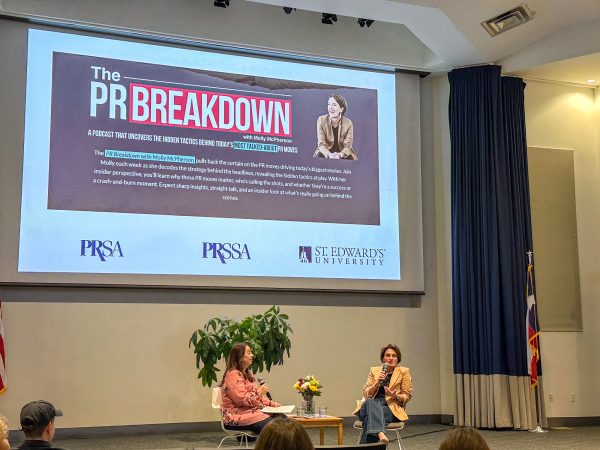Campus provides resources for students with eating disorders
The day after a classmate called St. Edward’s University sophomore Paris Lynch chubby, she forced herself to stop eating.
“It’s not just one part of you. It’s all: emotional, physical. You just want to fit in and weight is included in that,” Lynch said. “But the thing is, you can never win. When I finally weighed about 85 pounds, the same boy that said I was chubby said I was too thin.”
For a time, Lynch would exercise, but refuse food. She lost more than weight and she gained something too.
She gained the title anorexic.
“It started to consume me,” Lynch said. “I developed depression. I lost my friends.”
An eating disorder is a mental health illness which causes serious variations in a daily diet. The National Eating Disorders Association defines anorexics as people who starve themselves.
One in five women struggle with an eating disorder or disordered eating, according to National Institute of Mental Health. Lynch became one of those women.
The struggle, according to Lynch, is all-encompassing.
On college campuses, fluctuating weight is a part of the culture, Lynch said. Students refer to the first year of college as the time to get the freshman 15, or the time when they gain 15 pounds. There is not a common phrase for losing the freshman 15. However, losing weight quickly can lead to an eating disorder.
The Statistics
“College students have higher rates of mental health problems like depression than non-college students,” said Miki Tesh, a professor of social work at St. Edward’s.
This might be due to moving away from home, student debt, the combination of having to go to school and work or just being dumped in a brand new place, Tesh said. Eating disorders interact with other mental health issues such as those Tesh mentioned.
“Women with eating disorders are five times more likely to abuse alcohol/drugs; women with alcohol/drug abuse are 11 times more likely to have eating disorders,” according to the National Eating Disorders Association. “Twenty to 50 percent of women with eating disorders have history of trauma. Depression, anxiety disorders and personality disorders also co-exist.”
Of adolescent girls, 5 to 15 percent are currently using unhealthy methods to control their diet, such as self-induced vomiting, laxatives and diuretics, according to the World Health Organization (WHO).
Enrolled St. Edward’s students suffering from anything from minor stress to mental illnesses, such as eating disorders, are able to ask for help at the St. Edward’s Health and Counseling Center (HCC).
Campus Solutions
However, the HCC would not be able to help students who would need long-term counseling, said Dr. Galatia Cepeda, a staff psychologist at the HCC. Most students with eating disorders would require such long-term counseling because the most effective treatment is in the form of extended psychotherapy or psychological counseling, according to NEDA.
“The reality of the university counseling center world is that we are probably slightly understaffed and we’re using a short-term model,” Cepeda said. “Usually, severe chronic eating issue requires a referral, treatment clinics, comprehensive care, a therapist, a psychiatrist for medication, monitoring weight, monitoring electrolytes for patients with anorexia because of possible heart issues and a nutritionist.”
A psychiatrist, Dr. Daniel Skoglund, visits St. Edward’s several times a month. If need be, the HCC will subsidize the payment and ask the student pay a $25 co-pay to see Skoglund. Any visitations or follow-ups that are subsidized must be approved by the director of the Health and Counseling Center.
The HCC is able to help find, but not fund, community therapists or general practitioners, who are medical doctors who treat acute or chronic illnesses and may also provide preventative care.
Preventative measures are easier and less expensive than letting the problem become a chronic illness, said Cepeda.
St. Edward’s hired Pete Erickson, a licensed professional counselor, as an outreach coordinator and he works with the wellness coordinator, said Cepeda. Together, these organizations create Body Awareness Month, a month with events that is centered around body image and eating issues. Ironically, these events usually provide pizza, a high-calorie food
“Body Awareness Month 2014 supports the philosophy of behavior-centered health, which emphasizes healthy lifestyle choices and behaviors and deemphasizes a focus on size, weight or shape,” the Body Awareness Month webpage of 2014 said.
College students do not always see eating disorders in a negative light.
Media Enabling
There are websites or blogs that gear themselves specifically toward inspiring women with eating disorders to continue losing weight. These websites call themselves thinspiration. Thinspiration websites tout pro ana (pro anorexia) and pro mia (pro bulimia) tips and quotes.
“Nothing tastes as good as skinny feels,” a Kate Moss quote plastered on a pro anorexia website said.
People who do not have eating disorders cannot typically fathom why people would make themselves vomit like those with bulimia do, or worship women like Kate Moss.
People with bulimia binge, or eat large quantities of food, and then purge, or get rid of the food by ways such as self-induced vomiting or laxatives; but most unhealthily thin people who have an eating disorder are anorexic.
“People in my field seem angry about it,” Tesh said. “It’s like, ‘Why can’t you just eat?’ It’s the same anger people feel toward people with alcohol and drug addictions: ‘Why can’t you quit?’ I think people take it personal. They don’t understand.”






